Does anyone else fantasize about cured meats hanging from their kitchen beams or is it just me? Preparing meat so that it is room temperature stable is the oldest form of food preservation. Think about it. How else did people preserve an entire buffalo so that it didn’t spoil before they could eat it all? There were no refrigerators just good ole’ fashioned salt and smoke cures. So why are people nowadays so freaked out by a slab of meat hanging from the ceiling in my kitchen, yet they will eat a Little Debbie? Beats me.
One of the perks of living in a house as old as mine is that seasonally I have a natural curing chamber in my basement. In early spring when the snow is melting, we get rain, and the temperatures are starting to warm up, creating ideal conditions for hanging meat. The field stone foundation allows the house to breathe, which means some water gets in creating a humid environment with temperatures ranging in the mid 50’s. This is perfect, and doesn’t require a special curing chamber. It is however seasonal, and once we get into summer the constant humidity isn’t reliable enough. But like so many other things we do, I just plan ahead and this is the time when I do all of my curing for the year.
First, let me give my little disclaimer. This is my second year curing meat this way. The first year I was so anal about monitoring exact humidities, moisture loss, and the ratio of salt cure : weight of the meat. My guanciale came out perfect in terms of the cure itself (it ended up being tainted by glands which I will get into shortly) but it was a little exhausting obsessively checking on this slab of meat several times a day. This year I was like ya know what? People did this long before scales and hygrometers, so I’m going to take the more laid back approach. So I did. And you know what? It came out perfection. If you read other instructions on how to do this you will see everyone does it a bit different. Some people take a very scientific approach like I did last time and if you want to go that route that’s fine! But, if you take the same laid back approach as I do then this is the post for you friend.
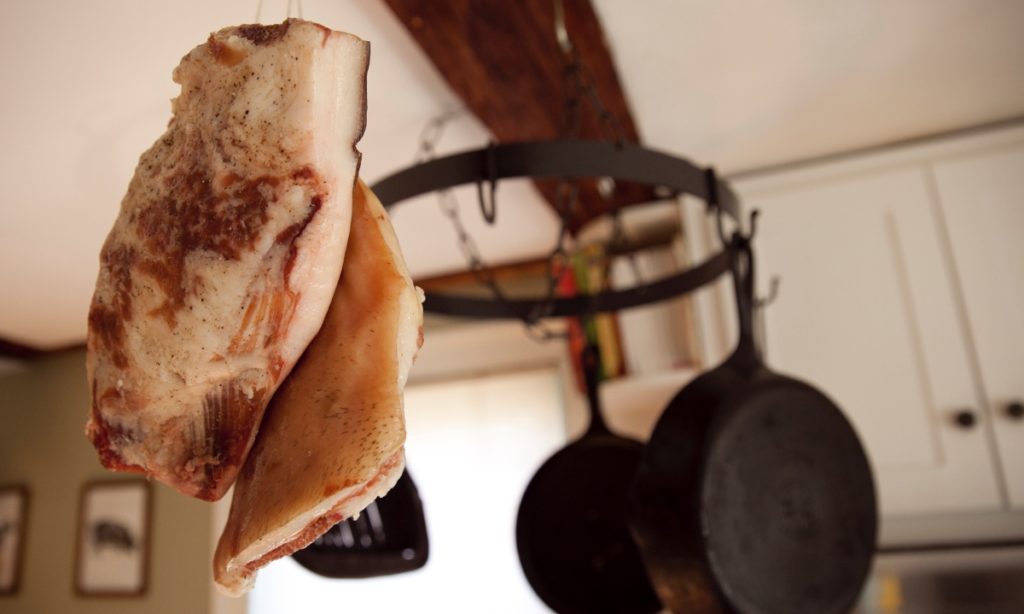
The Jowl
First things first, let’s talk about what guanciale actually is. Guanciale is a cured pork jowl, aka jowl bacon. It is an incredibly delicious, flavorful, and melt in your mouth charcuterie that elevates any dish. Are you familiar with pancetta? Pancetta is cured the exact same way, but it’s made from the pork belly versus jowl. Guanciale is a very underused ingredient in many Americanized Italian dishes, and pancetta is a common substitution. Now pancetta is well and good, and does make a fine substitution. But let’s be clear, if you want to make the best pasta carbonara or bucatini al’ amaritrician (my husbands absolute favorite meal in the world) of your life, guanciale will be the ingredient that takes it to another level. Well, that and fresh pasta.
The first thing you will want to do is source your jowl. Now if you raise your pigs like we do, this is easy. When you butcher it or get it back from the butcher you ask for whole fresh jowl. If you don’t raise pigs or get a hog share from someone else, then you will have to source one from a good butcher that does their own processing. This may be difficult to find because I’m not talking about your local Wal Mart.
Once you get your jowl, you will want to trim it if it hasn’t been done already by a butcher. Here is where I made my mistake last year. Pretty sad I doomed myself right off the bat but it’s all part of the learning experience! The reason for my mistake was because I was horrified by the amount that I was trimming off and was trying to salvage every last bit I could. Resist the temptation…cut it off! Now, I’m sure there are very skilled and seasoned butchers who are able to leave more flesh on because their experience has taught them how much they can get away with. Someday I hope to get to that point, but I’m not there yet. All I know is that I missed some glands when trying to salvage meat and it tainted the entire jowl. Devastating.
You want to cut out any ugly grayish looking things (those are glands) and also remove the cheek. Braise that baby! From there it’s a matter of trimming it up so it’s relatively even thickness, and making sure there aren’t any ragged pieces.
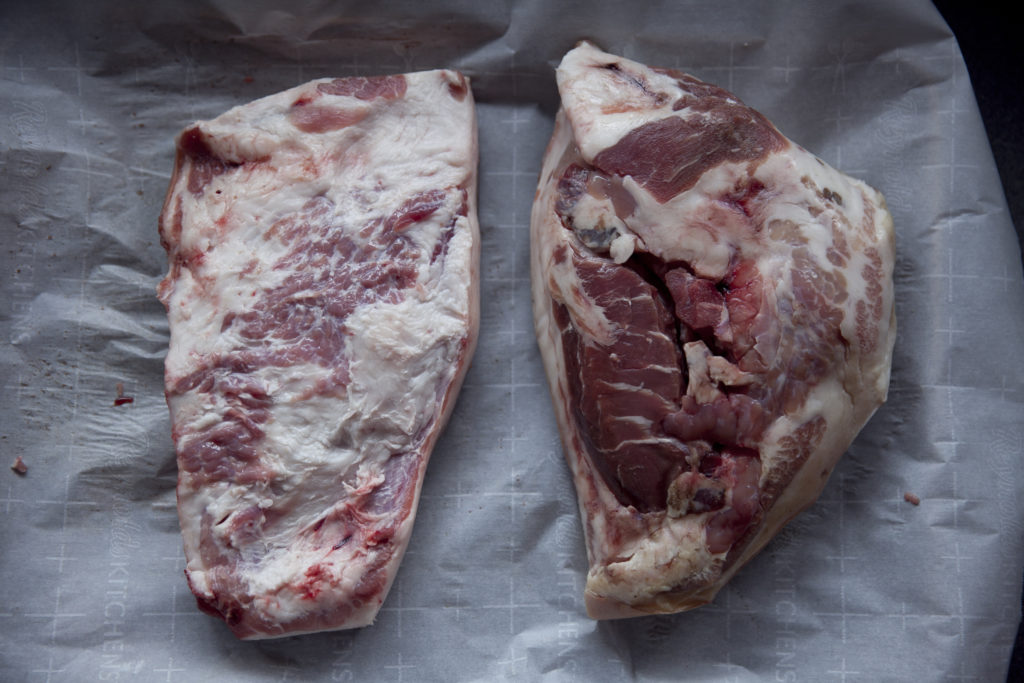
Salt Cure
Once your jowl is trimmed up, it’s time to get it in its salt cure. Now, here is where my more laid back method comes out to play. You will read methods that say you need to weigh the jowl, and then from there you use a percentage of its weight to calculate how much cure you need. Nahhhhh. All you need is some black pepper, kosher sea salt and some raw sugar (this is a nitrate free version by the way). Several recipes use a herbed spice blend that they rub on the guanciale, but I don’t do this either. I like my meat’s flavor to shine without any additional spices. So I just use black pepper and then a separate cure mixture of 50% salt and 50% sugar. That is it.
You will need a non reactive container of some sort like a glass baking dish to put your jowl in. Give the skin side a liberal sprinkling of the cure and rub it down, then add more cure to the bottom of the dish. Place the jowl skin side down in the baking dish. Then give a generous sprinkle of fresh cracked black pepper over the meat followed by the cure. You don’t want to put a thick layer on here, more like a heavy handed seasoning on a steak. Rub it in all over the flesh, cover it with saran wrap and stick it in the fridge.
For about the next week, everyday you will want to pour off any liquid that pools in the dish. Then, give a fresh light sprinkling of the cure and stick it back in the fridge. You will do this everyday until you see a noticeable drop in the amount of liquid the meat is releasing and it should feel firm, not floppy. This can take anywhere from 5-8 days.
The point of cure is to draw moisture out of the jowl. Moisture is the enemy when it comes to food preservation like this and what causes the meat to spoil, aka botulism. And that’s bad mmmkay. Once you see a drop in the liquid that’s released and it’s officially “cured”, wash it off really well with cool water and pat dry with a towel. Congratulations, you just made a room temperature stable meat!
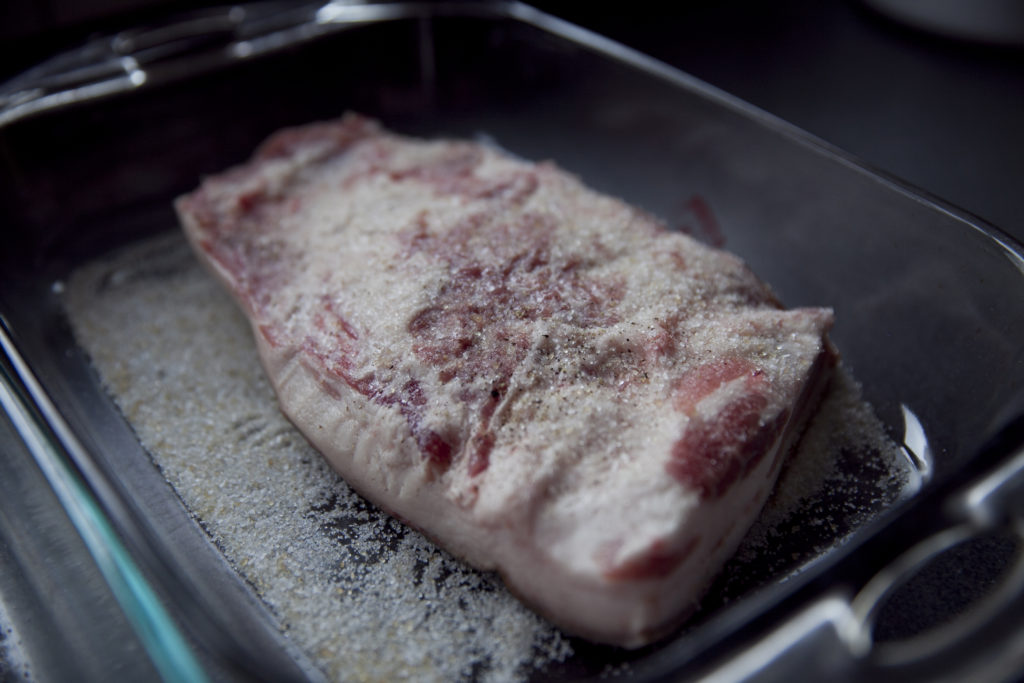
Hang It
With the jowl now room temperature stable, it’s time to let it hang! This is where my cool and humid basement comes into the picture. Like I said, this is the old fashioned way! First, you need to pierce a hole with a sharp knife through the thickest part of the jowl near an edge and fish some butcher twine through. This will allow you to hang it from the ceiling/beam/whatever. You don’t want it too close to the edge, otherwise the weight may cause your hole to rip and your jowl to fall.
When I hang my jowl I always give it a fresh coating of cracked black pepper and loosely tie cheesecloth around it. Like I said, this is hanging in my basement so this will help me tell if something has chewed on it like a mouse and just gives general protection from dirt and cobwebs. The black pepper will also help deter flies, and cheesecloth will keep them from laying eggs. This isn’t an issue here in the spring, but for some it may be.
Once my jowl has the string fitted through to hang, and has been coated with some black pepper and cheesecloth, I take it down to the basement and tie up on a beam that’s out of the way where I won’t bump into it, my cat can’t reach it, and it’s less likely to be found by a mouse. The basement is humid and cool.
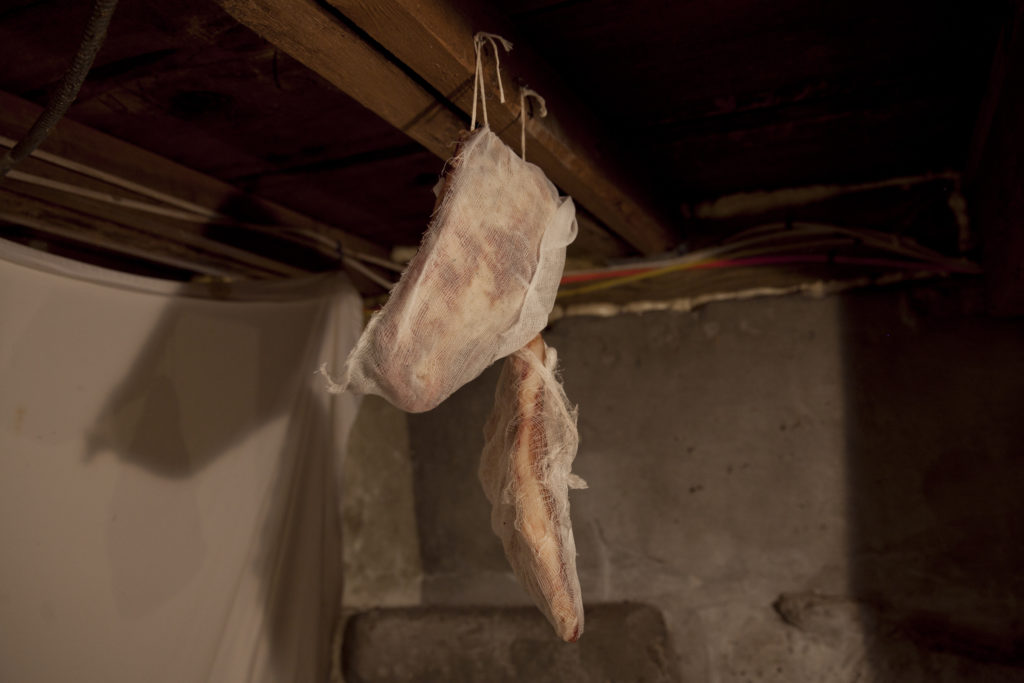
Humidity
Humidity is an extremely important variable in the curing process and last year I really got myself whipped up over it. Like I said before, you can get as scientific as you want about this, and some people regulate it down to the percentage point depending on how long it has been hanging. Last year I was down there fretting every time it dipped above or below the humidity I was trying to achieve during the stage of the hanging process.
This year? Nahhhhhhh. Just let it hang baby. While it may not be a constant (and it does fluctuate a bit), early spring creates the ideal conditions for me to hang my meat in the basement this way! My basement naturally maintains roughly 55%-65% relative humidity (RH), which is right within the range of “ideal”. So I let it hang care free and am not getting myself all worked up if it dips above or below the range for a few hours.
So what if you don’t have “ideal” relative humidity? Well, that’s when things can really go south. If conditions are too humid for an extended period of time like 80% and above, it can promote bad mold growth and spoilage. If conditions are too dry, and the humidity is less than mid 50’s for an extended period of time (this is most important when it initially hangs) it can cause the exterior to dry out and create a hard casing. Not only is this not appetizing, but the hard casing traps moisture in the meat inside causing it to spoil. Both scenarios can result in you having to pitch the jowl.
Temperature
Temperature is also an important variable in the curing process but fluctuations have a far less detrimental affect than humidity. The ideal temperature is in the 50’s which again, is the natural temperature in my basement this time of year. You certainly want to steer clear of excessively warm temperatures, but if it occasionally gets a little warmer than the 50’s it won’t hurt anything just like if it dips below the 50’s. This can have an affect on the final flavor of the guanciale due to warmer temperatures promoting fermentation while the cooler temperatures inhibit it. So, the mid 50’s is the ideal temperature to shoot for, but you won’t have your meat spoil if there is some fluctuation, it just may change the flavor a bit.
Curing Time
The amount of time you allow your jowl to hang is really up to you! Some may start cutting off it right out of the salt cure to start frying up. I on the other hand practice as much self control as possible and give it a few weeks to hang and develop that delicious aged flavor. The minimum amount of time you “should” let it hang is for 3-4 weeks. The longer you let it hang, the more moisture it looses, and the stronger the flavor develops. This truly is a personal choice dependent upon your tastes. Mine hung in the basement for three weeks then got moved upstairs to hang in the kitchen. It’s been hanging there for over a month, and I’m down to one jowl
At this point the woodstoves are no longer in use, meaning my kitchen is still relatively humid so they can continue to cure and age. They hang from the beam next to my skillets within convenient reach for me to cut off a hunk and fry up for dinner. As soon as the jowls start to become stale or we need to fire up the woodstoves again (this is assuming the guanciale even makes it that long) I will cut up what is left into chunks and put it in the freezer.
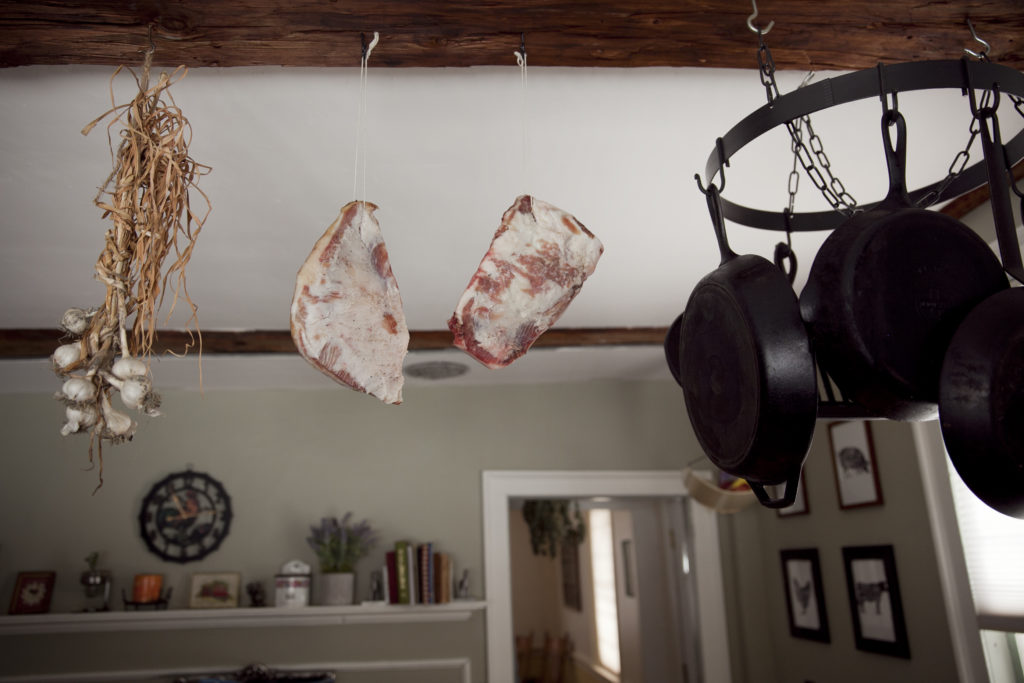
Do not fear the cured jowl and think you’re going to die if you eat it. Let your nose be your guide, it won’t steer you wrong. If something doesn’t smell right, then it probably isn’t! It should have an almost sweet smell to it, and you will know something isn’t right if it smells rancid or like ammonia.
Also, don’t be afraid if you see mold! There are several types of good molds out there and its presence alone shouldn’t scare you. Most white molds are good (think penicillin) although not all are. I am far from a mold expert, but if you see some growing on your jowl and it bothers you, just wipe it off with a white vinegar soaked towel. So far I have only ever had minimal white non-hairy mold growing on my guanciale and I left it and ate it anyway. I’m still here!
Okay, so maybe you’re like hey this is all well and good but I don’t have a 220 year old house with a field stone basement! Well, it doesn’t have to be a basement! Any room will do, as long as it’s cool, dark, and humid. Maybe you have a spare bathroom no one ever uses? Or a good spot in your laundry room? If you’re missing one the variables naturally, say your room gets a bit colder than the 50˚F range for example. Get a cheap little space heater to help bring up the temperature a bit. Or, use a humidifier if it’s humidity you’re lacking! Although yes, an old basement is “the old fashioned way” you can replicate these same conditions in other rooms, or maybe they occur naturally! It’s the conditions that matter, not what room you use to cure.
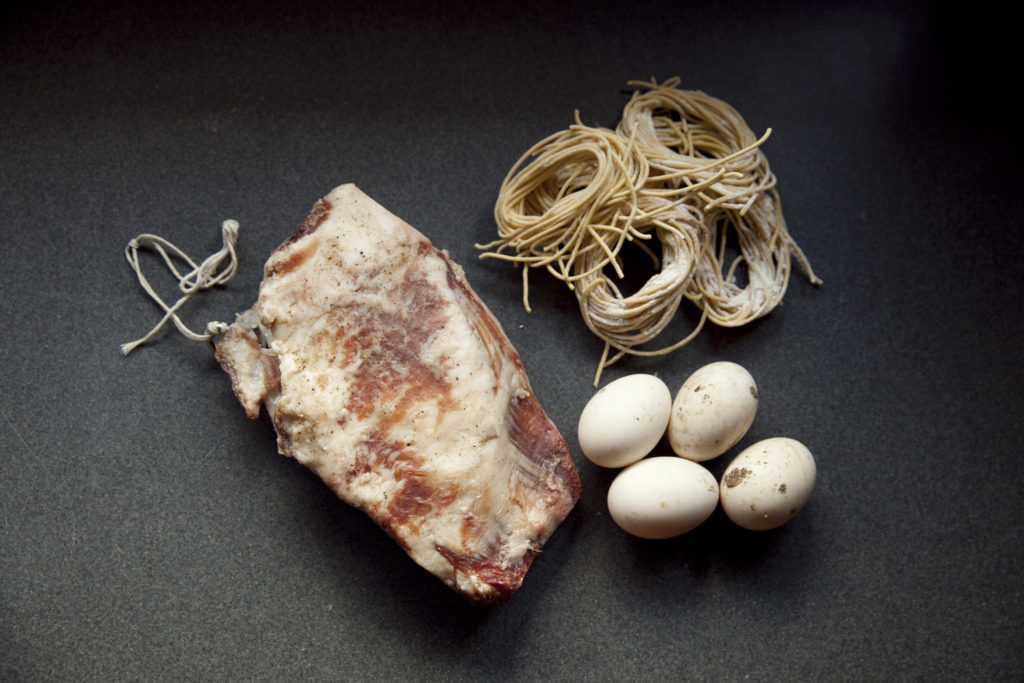
Guanciale is an easy cut of pork to cure along with belly bacon and is great for beginners to get their feet wet. Maybe you can’t get your hands on a jowl but have a nice belly? Great, just go back through this blog post and substitute the word “jowl” for “belly” and you have your instructions. You can hang it flat just like a jowl or roll it up REALLY tight so you don’t trap air, tying every inch or so with butcher twine. I let my pancetta hang for less time than guanciale, 2-3 weeks depending on conditions.
I feel like “we” as a culture with our need for instant gratification have lost touch with the seasonality of things. If you just pay attention to the natural ebb and flow of the seasons, you will see nature provides. Just like an oak dropping its nutrient dense acorns in the fall makes the perfect time to finish pigs, or the sap running in the spring provides maple syrup. The change from winter to spring creates the ideal conditions here to cure meat naturally. All you have to do is slow down and listen to nature’s cues. I highly recommend giving it a try to anyone who has a love for this delicious bacon delicacy. And may we all have cured meats hanging from our beams with hooks!
Happy Curing,



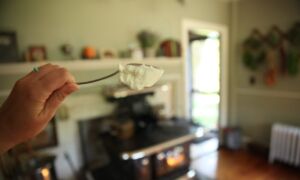
Looks wonderful!! I just found your blog this week, and I’ve been voraciously reading all your past posts. My husband and I are looking to buy a small acreage and do something similar in a year or two. Have you ever done a post about your daily chores/schedule? I think it’s be really interesting!